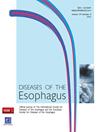462. EPIPHRENIC DIVERTICULA. THERAPEUTIC ALTERNATIVES AND OUR EXPERIENCE
IF 2.3
3区 医学
Q3 GASTROENTEROLOGY & HEPATOLOGY
引用次数: 0
Abstract
Background Epiphrenic diverticula account for less than 10% of esophageal diverticula and they are located in the last 10cm, in the right posterior quadrant. They are pseudodiverticula, lacking the muscular layer. Recent studies report that over 75% of these occur concomitantly with esophageal motility disorders, making it essential to evaluate them via manometry before deciding on intervention. Asymptomatic patients usually receive non-operative treatment. Indications for surgical treatment include increased diverticulum size, specific symptoms and suspicion of malignancy. Standard surgical treatment consists of laparoscopic approach with diverticulectomy, myotomy and Dor fundoplication. Methods We had 9 cases of esophageal epiphrenic diverticula that required surgical intervention in the last 16 years. In the vast majority of them, laparoscopic diverticulectomy was performed, along with myotomy and Dor fundoplication. Among them, there is a rare case of recurrence of a giant epiphrenic diverticulum in a 55-year-old patient treated with this approach. Due to the complexity of the case, partial esophagectomy and reconstruction with right-sided ascending coloplasty via posterior mediastinal route were decided as definitive treatment. Results The outcome was satisfactory in almost all patients, being the most frequent complications a suture line dehiscence and associated mediastinitis. Conclusion Esophageal diverticular pathology is uncommon, and its treatment is conservative in most cases. Over 75% of epiphrenic diverticula occur in the context of an underlying esophageal motor disorder. Indications for surgical intervention are the presence of symptoms, increased diverticulum size and suspicion of malignancy. The standard treatment consists in diverticulectomy, myotomy and fundoplication, but there are therapeutic alternatives that should be considered and individualized in each case. Symptoms disappearance after surgical treatment is nearly 90%. However, the procedure carries a morbidity and mortality rate of 20%, being the most common complication a suture line dehiscence, occurring in 33% of cases.462.虹膜憩室。治疗方法和我们的经验
背景 虹膜上憩室占食管憩室的比例不到 10%,位于右后象限的最后 10 厘米处。它们属于假性憩室,缺乏肌肉层。最近的研究报告显示,超过 75% 的食管憩室同时伴有食管运动障碍,因此在决定是否进行干预之前,必须通过测压法对其进行评估。无症状患者通常接受非手术治疗。手术治疗的指征包括憩室体积增大、特殊症状和怀疑恶性肿瘤。标准手术治疗包括腹腔镜憩室切除术、肌层切开术和多尔胃底折叠术。方法 在过去的 16 年中,我们接诊了 9 例需要手术治疗的食管虹膜上憩室患者。其中绝大多数病例都进行了腹腔镜憩室切除术、肌切开术和多氏胃底折叠术。在这些病例中,有一例罕见的病例,55 岁的患者通过这种方法治疗后,巨大的虹膜上憩室复发。鉴于该病例的复杂性,最终决定采用食管部分切除术和经后纵隔途径的右侧升结肠成形术重建食管。结果 几乎所有患者的治疗效果都令人满意,最常见的并发症是缝合线开裂和相关纵隔炎。结论 食管憩室病变并不常见,大多数情况下采用保守治疗。超过 75% 的虹膜上憩室是在潜在食管运动障碍的情况下发生的。手术治疗的指征是出现症状、憩室增大和怀疑恶性肿瘤。标准治疗方法包括憩室切除术、肌切开术和胃底折叠术,但也有其他治疗方法,应根据每个病例的具体情况加以考虑。手术治疗后症状消失率接近 90%。不过,手术的发病率和死亡率为 20%,最常见的并发症是缝合线开裂,发生率为 33%。
本文章由计算机程序翻译,如有差异,请以英文原文为准。
求助全文
约1分钟内获得全文
求助全文
来源期刊

Diseases of the Esophagus
医学-胃肠肝病学
CiteScore
5.30
自引率
7.70%
发文量
568
审稿时长
6 months
期刊介绍:
Diseases of the Esophagus covers all aspects of the esophagus - etiology, investigation and diagnosis, and both medical and surgical treatment.
 求助内容:
求助内容: 应助结果提醒方式:
应助结果提醒方式:


